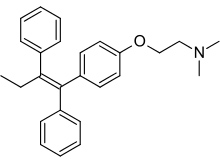Tamoxifen
Tamoxifen is currently the first-line therapy for treatment of hormone-dependent breast cancer, it acts as an estrogen agonist by preventing the skeletal alterations that result from ovarian hormone deficiency.
Inquire / Order:
manager@chemfaces.com
Technical Inquiries:
service@chemfaces.com
Tel:
+86-27-84237783
Fax:
+86-27-84254680
Address:
1 Building, No. 83, CheCheng Rd., Wuhan Economic and Technological Development Zone, Wuhan, Hubei 430056, PRC
Providing storage is as stated on the product vial and the vial is kept tightly sealed, the product can be stored for up to
24 months(2-8C).
Wherever possible, you should prepare and use solutions on the same day. However, if you need to make up stock solutions in advance, we recommend that you store the solution as aliquots in tightly sealed vials at -20C. Generally, these will be useable for up to two weeks. Before use, and prior to opening the vial we recommend that you allow your product to equilibrate to room temperature for at least 1 hour.
Need more advice on solubility, usage and handling? Please email to: service@chemfaces.com
The packaging of the product may have turned upside down during transportation, resulting in the natural compounds adhering to the neck or cap of the vial. take the vial out of its packaging and gently shake to let the compounds fall to the bottom of the vial. for liquid products, centrifuge at 200-500 RPM to gather the liquid at the bottom of the vial. try to avoid loss or contamination during handling.
Horticulture Research2020, 7:111.
iScience.2024, 4790628.
Green Chem.2023, 25:5222-5232
Preprints2024, 2085.v1
Eur J Neurosci.2021, 53(11):3548-3560.
Nat Prod Sci.2018, 24(2):109-114
Cell Commun Signal.2024, 22(1):597.
UDC.2020, 19(4).
Front Pharmacol.2024, 15:1439079.
Universite de Bordeaux2017, 2017BORD0867
Related and Featured Products
J Bone Miner Res. 1987 Oct;2(5):449-56.
Tamoxifen prevents the skeletal effects of ovarian hormone deficiency in rats.[Pubmed:
3455628 ]
To determine whether the nonsteroidal antiestrogen Tamoxifen behaves as either an agonist or antagonist of estrogen on bone, the effects of ovariectomy, 17 beta-estradiol, and Tamoxifen were compared on radial growth at the tibial diaphysis in young adult female rats.
METHODS AND RESULTS:
Ovariectomy and 17 beta-estradiol did not alter serum calcium, phosphate, or 25-hydroxyvitamin D. Ovariectomy increased serum 1,25-dihydroxyvitamin D in one experiment but not in the other. Tamoxifen increased the serum calcium and phosphate by itself and did not change serum 1,25-dihydroxyvitamin D in ovariectomized rats. Ovariectomy produced significant increases in medullary area, periosteal bone formation rate, and periosteal bone apposition rate compared to values in sham-operated animals and did not change endosteal bone formation rate. The increase in medullary area resulted from an increase in osteoclast number and resorbing surface length. Although endosteal forming surface length decreased, this was compensated for by an increase in the apposition rate. 17 beta-estradiol and Tamoxifen each prevented the increases in bone formation rate and medullary area in ovariectomized rats. Tamoxifen reduced the length of the resorbing surface and osteoclast number to values observed in sham-operated animals.
CONCLUSIONS:
The findings demonstrate that in the rat, Tamoxifen acts as an estrogen agonist by preventing the skeletal alterations that result from ovarian hormone deficiency.
Cancer Res. 1999 Nov 1;59(21):5421-4.
Increased expression of estrogen receptor beta mRNA in tamoxifen-resistant breast cancer patients.[Pubmed:
10554009]
Tamoxifen is currently the first-line therapy for treatment of hormone-dependent breast cancer. However, despite initial benefits, most patients eventually relapse.
METHODS AND RESULTS:
Two groups of patients were identified: (a) a Tamoxifen-sensitive group (n = 8); and (b) a Tamoxifen-resistant group (n = 9). Using reverse transcription-PCR, the relative expression of mRNA for both estrogen receptor (ER) beta and transforming growth factor beta1 was determined in each patient group and quantified against a known reference standard. ER-beta mRNA was significantly up-regulated in the Tamoxifen-resistant group as compared with the Tamoxifen-sensitive group (P = 0.001 by Fisher's exact test), and, consistent with previous findings, transforming growth factor beta1 was also up-regulated in the Tamoxifen-resistant cohort (P = 0.02).
CONCLUSIONS:
The importance of ER-beta in Tamoxifen resistance was validated using Tamoxifen-sensitive and -resistant cell lines, in which it was demonstrated that ER-beta mRNA was significantly up-regulated in the resistant cells. These results lend further support to a role for ER-beta as a poor prognostic factor in breast cancer.



